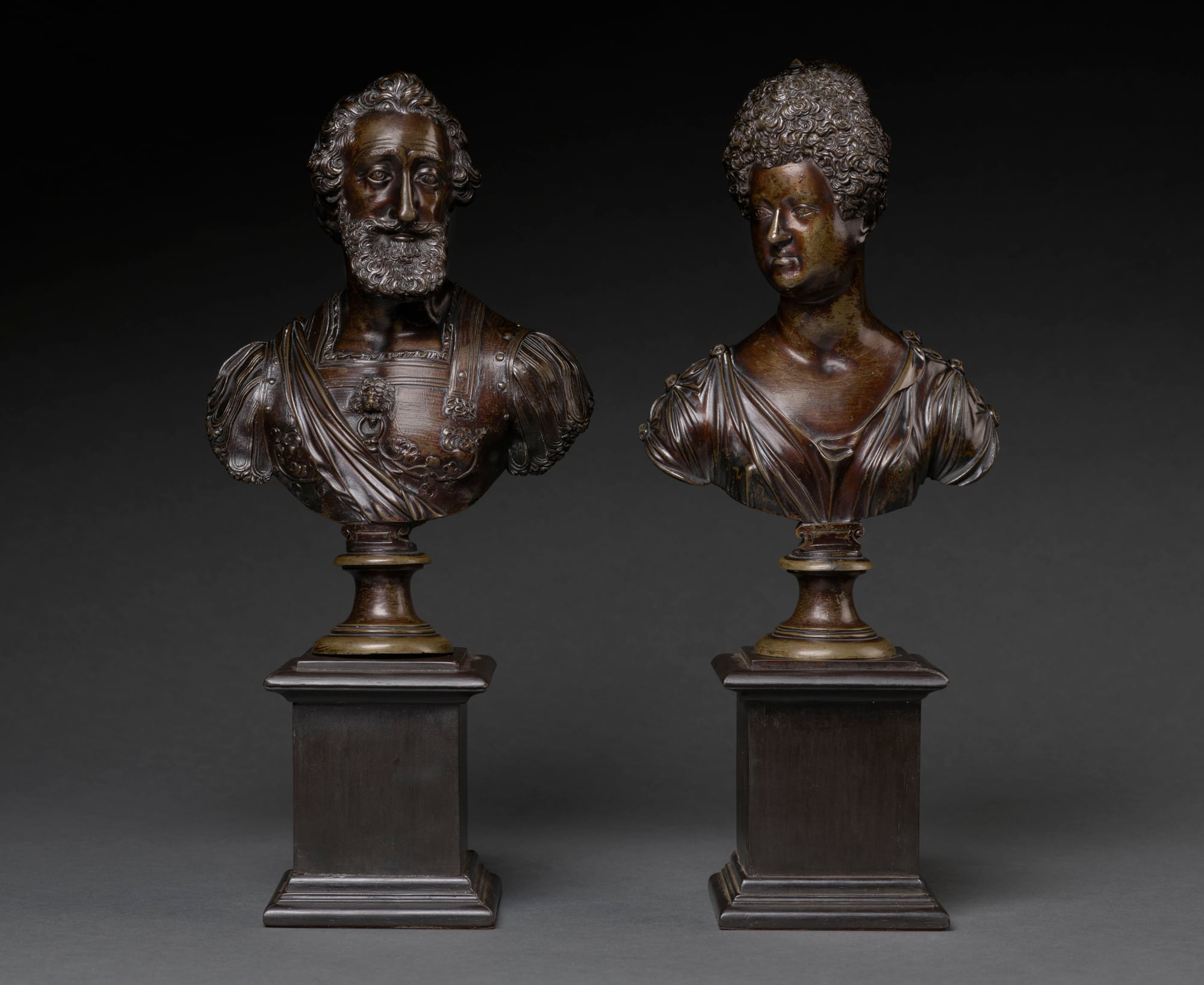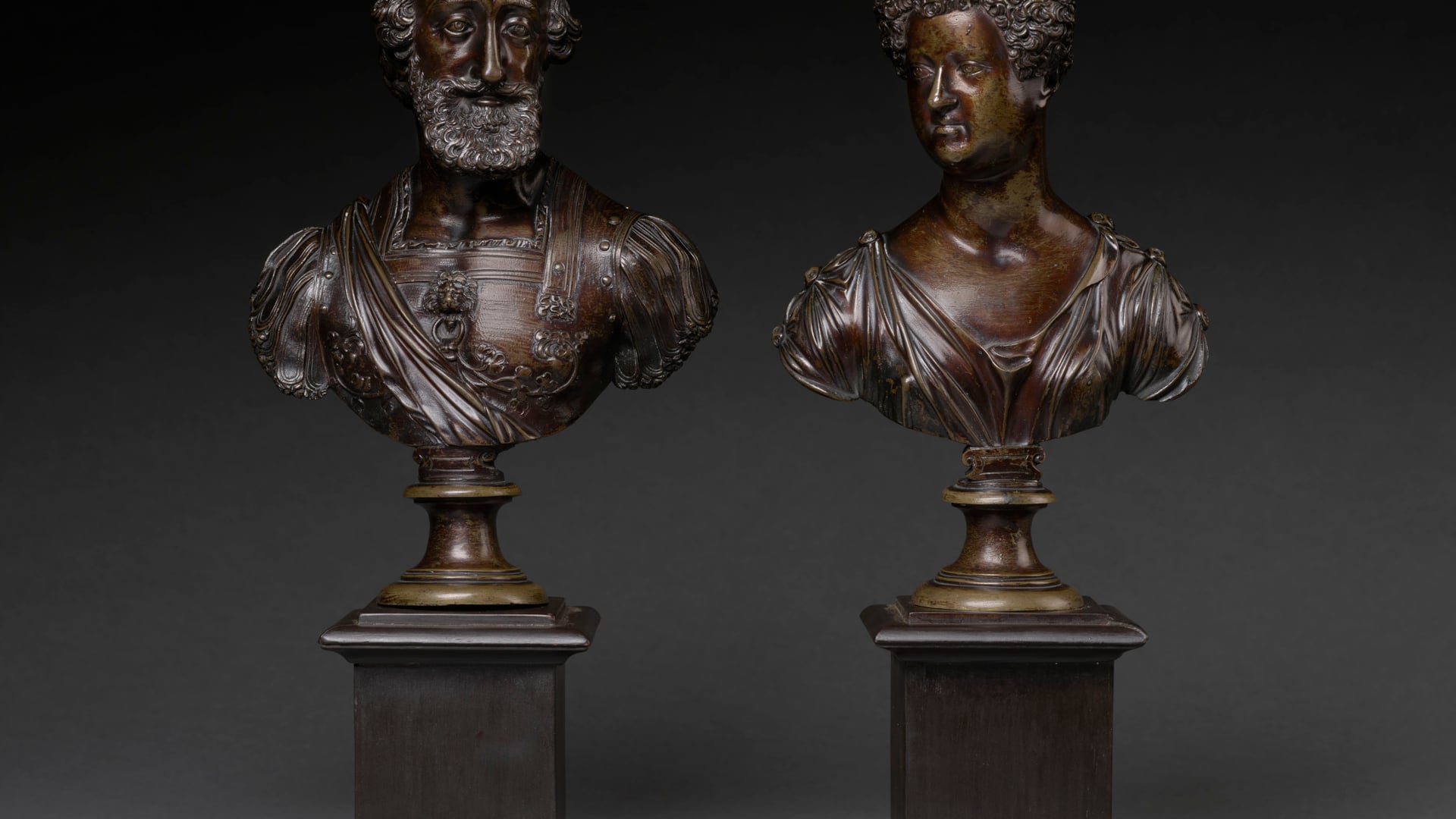

Collection Jacques Kugel,
Galerie Antony Embden,
Collection Pierre Bergé, acquired above
His sale, Sotheby's Paris, 31 October 2018, lot 155,
where acquired by Antony Embden, to 2022
Galerie Antony Embden,
Collection Pierre Bergé, acquired above
His sale, Sotheby's Paris, 31 October 2018, lot 155,
where acquired by Antony Embden, to 2022
G. Bresc-Bautier, G. Scherf, Bronzes français de la Renaissance au Siècle des lumières, exh. cat. musée de Louvre, Paris, 2008, pp. 126-127, no. 23 et 24.
Henry IV is depicted here wearing Roman armour while the queen, Marie de Medici, whom he had married by proxy in 1600, wears a classic dress. We know that a few small portraits of the bust of the king and the queen appear in the inventory after the death of Prieur in 1611. All specialists today consider them by his hand although they had previously been attributed to his son-in-law, the medallist Guillaume Dupre (1574-1642). Small bust portraits of Henri IV and Marie de Médici are of a style and a format similar to two allegorical busts respectively representing France and Navarre, also attributed to Prieur also on the basis of the same inventory. Other pairs of these models are in the Los Angeles County Museum of Art (inv. no. 81.22.1 and 81.22.2), and in the museum of Pau (on loan from the Louvre) (cf. G. Bresc-Bautier, op. cit., pp. 126-127, no. 23 & 24).
The very great resemblance between the heads of these bronzes and those of the bronze statuettes representing Henri IV as Jupiter (fig.1) and Marie de' Medici as Juno (fig. 2) confirms their attribution to Prieur. Research conducted at the Los Angeles County Museum of Art from 1996 to 1998 by Marco Leona, scholarship holder at the Mellon Foundation for the restoration, showed that the bronze versions of Henri IV in Oxford (Ashmolean Museum), Pau, and Los Angeles are all technically similar. Marco Leona further demonstrated that the Los Angeles busts present the same alloy, the same type of core supports and tiny and precise cappings, identical to those of the statuettes, which implies that they come from the same workshop and that they were undoubtedly designed as pendants.
Prieur, who like Henri, was a Protestant, had no difficulty obtaining the favours of the king and the importance of belonging to the same religion in order to obtain artistic patronage has been clearly summarized by Regina Seelig-Teuwen (1992, P.332-333). The entry into office of Prieur as sculptor to the king in December 1591 marks a decisive turning point in the history of French art. One year after the extinction of the Valois dynasty in 1589 Germain Pilon, the Crown's favourite sculptor for three decades, died. The reign of Henri IV marked the beginning of the Bourbon dynasty. Although Pilon's language has been taken up by Matthieu Jacquet in a Mons mannerist vein, the Florentine style was beginning to be appreciated and to supplant the latter. It is difficult to establish whether this development is attributable to the taste of Queen Marie de' Medici or the great popularity of the bronzes of Giovanni de Bologna. Either way, it is logical to assume that the multiple small bronzes appearing in the inventory after Prieur's death had to their existence both to one and to the other. R. Seelig-Teuwen has at all- times pointed out that the continual production of these busts of the king and the queen was a feature of his workshop (1992, p. 345). Henri IV understood that it was urgent to strengthen his power and the dissemination of his image was one of the means he used. The humanist Pierre-Antoine de Rascas de Bagarris (1562-1620), to whom had been entrusted in 1602 the responsibility of giving new impetus to the royal collection of medals and other antiquities, perhaps served as an adviser.
The very great resemblance between the heads of these bronzes and those of the bronze statuettes representing Henri IV as Jupiter (fig.1) and Marie de' Medici as Juno (fig. 2) confirms their attribution to Prieur. Research conducted at the Los Angeles County Museum of Art from 1996 to 1998 by Marco Leona, scholarship holder at the Mellon Foundation for the restoration, showed that the bronze versions of Henri IV in Oxford (Ashmolean Museum), Pau, and Los Angeles are all technically similar. Marco Leona further demonstrated that the Los Angeles busts present the same alloy, the same type of core supports and tiny and precise cappings, identical to those of the statuettes, which implies that they come from the same workshop and that they were undoubtedly designed as pendants.
Prieur, who like Henri, was a Protestant, had no difficulty obtaining the favours of the king and the importance of belonging to the same religion in order to obtain artistic patronage has been clearly summarized by Regina Seelig-Teuwen (1992, P.332-333). The entry into office of Prieur as sculptor to the king in December 1591 marks a decisive turning point in the history of French art. One year after the extinction of the Valois dynasty in 1589 Germain Pilon, the Crown's favourite sculptor for three decades, died. The reign of Henri IV marked the beginning of the Bourbon dynasty. Although Pilon's language has been taken up by Matthieu Jacquet in a Mons mannerist vein, the Florentine style was beginning to be appreciated and to supplant the latter. It is difficult to establish whether this development is attributable to the taste of Queen Marie de' Medici or the great popularity of the bronzes of Giovanni de Bologna. Either way, it is logical to assume that the multiple small bronzes appearing in the inventory after Prieur's death had to their existence both to one and to the other. R. Seelig-Teuwen has at all- times pointed out that the continual production of these busts of the king and the queen was a feature of his workshop (1992, p. 345). Henri IV understood that it was urgent to strengthen his power and the dissemination of his image was one of the means he used. The humanist Pierre-Antoine de Rascas de Bagarris (1562-1620), to whom had been entrusted in 1602 the responsibility of giving new impetus to the royal collection of medals and other antiquities, perhaps served as an adviser.